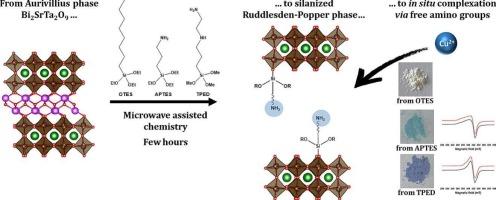Aurivillius相Bi2SrTa2O9的拓扑化学硅化及合成后络合
IF 5.8
2区 地球科学
Q2 CHEMISTRY, PHYSICAL
引用次数: 0
摘要
层状氧化物的功能化,以传递易于在无机层之间的配位金属阳离子的反应功能,是一个挑战,就氧化物与这些基团的潜在反应性而言。本文提出用含胺烷氧基硅烷进行硅烷化是一种将游离胺基引入层间空间的便捷方法。然而,对于层状氧化物而言,硅烷化本身很少被研究。本研究提出了一种微波辅助多步骤有机硅烷功能化Aurivillius Bi2SrTa2O9相的方法。在层间空间插入三乙氧基辛基硅烷、3-(氨丙基)三乙氧基硅烷和N-[3(三甲基氧基)丙基]乙二胺三种有机硅烷。本文描述的合成途径是一种快速有效的方法,可以将层状钙钛矿的层间空间硅化,同时保持层状结构。通过x射线衍射(XRD)和固体核磁共振(NMR)对化合物进行了全面表征,结果表明有机硅烷可以有效地接枝到氧化层上,形成稳定的Si-O-Ta键,并且可以精确地接枝方案,证明硅氧烷网络的形成非常有限。使用这种方法,由于氧化物片与烷氧基硅烷基团相比胺具有优先反应性,因此在无机氧化物层之间引入了自由氨基。这些氨基可以通过合成后的络合反应与过渡金属离子进一步配位。通过紫外-可见(UV-Vis)光谱和电子顺磁共振(EPR)光谱证明了它们对Cu2+离子的络合能力。这种软化学策略构成了一种新的通用、快速和有效的方法,将过渡金属阳离子引入层状氧化物中,为设计和合成复杂结构铺平了道路,这些结构专门用于催化、传感器、金属阳离子修复或发光等应用。本文章由计算机程序翻译,如有差异,请以英文原文为准。

Topochemical silanization of the Aurivillius phase Bi2SrTa2O9 and post-synthesis complexation
Functionalization of layered oxides to convey a reactive function prone to coordinate metal cations in-between the inorganic layers is a challenge with respect the potential reactivity of the oxides with these groups. Here, silanization by amine-bearing alkoxysilanes was proposed as a convenient way to bring in free amine groups in the interlayer space. Yet, silanization in itself has seldom been explored for layered oxides.
This study presents a microwave-assisted multistep approach for functionalizing the Aurivillius Bi2SrTa2O9 phase by organosilanes. Three different organosilanes were inserted in the interlayer space, triethoxyoctylsilane, 3-(aminopropyl)triethoxysilane and N-[3(trimethyoxysilyl)propyl]ethylenediamine. The synthetic pathway described here constitutes a fast and efficient approach to silanize the interlayer space of layered perovskites, while preserving the layered structure. The compounds were fully characterized, notably by X-Ray Diffraction (XRD) and solid state Nuclear Magnetic Resonance (NMR), which demonstrated that the organosilanes were effectively grafted onto the oxide layers, forming stable Si-O-Ta bonds, and allowed to precise the grafting scheme, evidencing the very limited formation of siloxane network. Using this approach, free amino groups were introduced in-between the inorganic oxide layers due to the preferential reactivity of the oxide sheets with the alkoxysilane groups compared to amine. These amino groups are available for further coordination by transition metal ions using a post-synthesis complexation reaction. As a proof of concept their complexation ability towards Cu2+ ions was demonstrated by UltraViolet-Visible (UV–Vis) and Electron Paramagnetic Resonance (EPR) spectroscopies.
This soft chemistry strategy constitutes a new versatile, fast and efficient method to introduce transition metal cations into layered oxides and paves the way for the design and synthesis of complex architectures, specifically designed for application, in catalysis, sensors, metal cation remediation or luminescence for instance.
求助全文
通过发布文献求助,成功后即可免费获取论文全文。
去求助
来源期刊

Applied Clay Science
地学-矿物学
CiteScore
10.30
自引率
10.70%
发文量
289
审稿时长
39 days
期刊介绍:
Applied Clay Science aims to be an international journal attracting high quality scientific papers on clays and clay minerals, including research papers, reviews, and technical notes. The journal covers typical subjects of Fundamental and Applied Clay Science such as:
• Synthesis and purification
• Structural, crystallographic and mineralogical properties of clays and clay minerals
• Thermal properties of clays and clay minerals
• Physico-chemical properties including i) surface and interface properties; ii) thermodynamic properties; iii) mechanical properties
• Interaction with water, with polar and apolar molecules
• Colloidal properties and rheology
• Adsorption, Intercalation, Ionic exchange
• Genesis and deposits of clay minerals
• Geology and geochemistry of clays
• Modification of clays and clay minerals properties by thermal and physical treatments
• Modification by chemical treatments with organic and inorganic molecules(organoclays, pillared clays)
• Modification by biological microorganisms. etc...
 求助内容:
求助内容: 应助结果提醒方式:
应助结果提醒方式:


